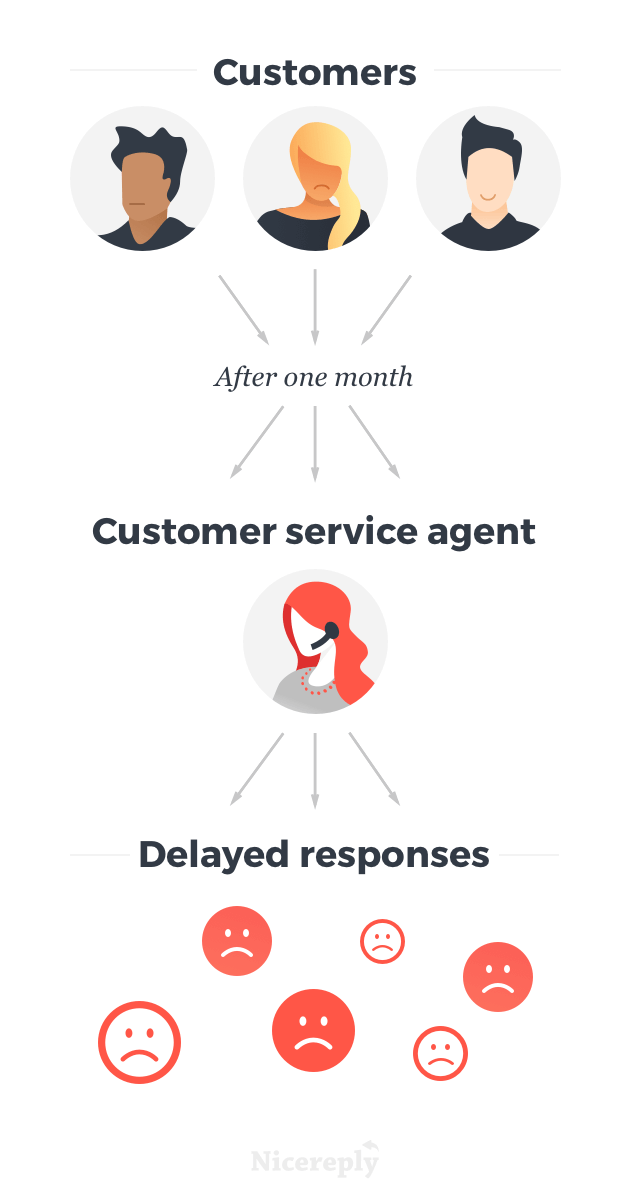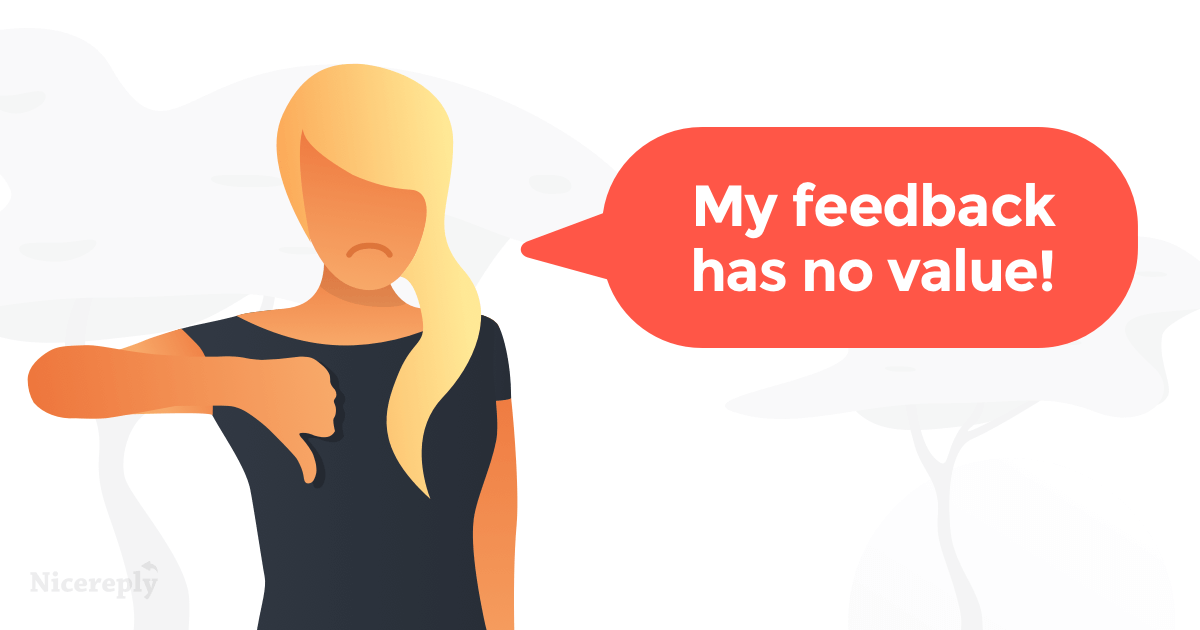Real time feedback is the dashboard for customer support teams.
When you’re driving a car, you have a full array of dashboard information telling you what’s happening to the car.
If the car is running out of fuel, it’s time to find a gas station. If the oil pressure is low, we head to a garage to change the oil. We can also get status reports from the feeling of the car running – for example, when the road is bumpy, you can choose to slow down.
Now, imagine you had to check under the hood every time you wanted to know the status of the car. Or worse yet, you were driving the car remotely, with no haptic feedback. It would be very difficult to drive the car well, or make decisions to keep the car running smoothly.
Why traditional feedback programs fall short
Many feedback programs fall short in two ways. They aren’t real time, or they aren’t delivered to the right person when it counts.
Quarterly customer service surveys carry an inherent flaw – they depend on customer’s memories, which dramatically deteriorate over time. Surveys about large purchases can also be subject to cognitive dissonance bias. Customers making purchases with a large degree of commitment try to convince themselves that they made the right choice. They will look more positively on a large purchase due to cognitive dissonance, and this bias appears in post-purchase surveys.
Even if companies are surveying customers immediately after service interactions, monthly, they compiled the results and sent to an executive team member for review. While reports are important to analyze the big picture, the executive team member is often not in a position to respond to any unhappy customers. This delay makes customers feel like companies don’t value their feedback. By the time they forwarded the feedback to the appropriate front line member, but customer has already moved on.

Three benefits of real time customer feedback
There’s three important reasons every customer service team should develop a real-time feedback loop with their customers:
- It’s much easier to resolve issues faster
- Executives are able to understand the customer experience
- Feedback is a powerful training tool for agents.
More Effective Service Recovery
Reacting to unhappy customers more quickly increases the likelihood of customer recovery. Apologizing to dissatisfied customers results in 54% to 70% of customers buying again due to an effective resolution. However, this effect is amplified to 95% of unhappy customers buying again if they feel the complaint was resolved quickly.
“Of the customers who register a complaint, between 54 and 70% will buy again if their complaint is resolved. The figure goes up to a staggering 95% if the customer feels the complaint was resolved quickly.” – Albrecht and Zemke, Service America

The only way to resolve customer concerns quickly is through a real time feedback loop. Routing unhappy customer comments back to the agent (or their supervisor) allows for immediate follow-up. Without a real time feedback loop, the customer may have to write in again. Also wait for the customer support manager to review poor satisfaction surveys at the end of the week or even worse – take to Twitter.
Think of it as servicing your car when the warning light comes on compared to waiting until smoke is billowing out from under the hood.
Not only is a quick response more likely to repair the situation, it’s also more likely to prevent the news from spreading. A dissatisfied customer will tell an average of 9.5 people about their experience. 13% of unhappy customers will even get the word out to more than 20! (Accenture). In today’s social world, it only takes one tweet to ruin the reputation of your service organization.
Solving problems quickly can prevent negative customer service stories from going viral. Every second counts when responding to negative customer satisfaction scores.
Bring Executives Closer to the Customer
Teams often create a level of abstraction between customer feedback and the C-Suite. They believe that leadership shouldn’t be distracted by emotional, anecdotal stories. Instead of the executive team hearing directly from customers, they get anonymized data points. This sanitized data carries a risk of desensitizing leadership to real life customers.
Rather than being distracting, real time feedback is illuminating for senior leadership.
As the layers of hierarchy increase between front line teams and the C-Suite, the empathy for the customer experience can decrease. It’s difficult to identify with a specific customer when their feelings are reduced to a single data point on a graph.
Forwarding feedback to executives in real time helps reduce this empathy gap and can help drive customer-centric decision making.
At Rackspace, several customer survey responses are routed to CEO Lanham Napier each week, who then calls the customers. These personal conversations help guide the CEO to making customer-centric business decisions and keeping actual customer top of mind.
Reduce Training Costs
Law of effect is a psychological theory that states “behaviors followed by satisfying consequences tend to be repeated and those produce unpleasant consequences are less likely to be repeated.”

Imagine going above and beyond for a customer and instantly receiving a positive, personalized comment back from them. You’d be much more likely to continue delivering great service, than if you heard nothing back. On the other hand, if you cut corners and receive a poor customer survey back, it’s much easier to identify and eliminate these behaviors.
Bain and Co explain how this works with call center escalations: “At Progressive Insurance, for example, supervisors who close the loop with unhappy customers record the call (with permission). Then forward the digital voice file to the employee who served that customer. Hearing the customer’s actual voice lets the employee absorb the tone and feel the emotional impact. That alone often motivates learning and changes in behavior, with little additional coaching required.”
Removing the front line agent from the feedback loop, removes the stimulus that drives improvement through the law of effect. If agents never hear back from customer conversations, they won’t know how they are doing, and can’t make the changes to improve.
Set up Your Real Time Feedback System
There’s three parts required for effective real time feedback:
- One-click customer surveys: using a platform like Nicereply allows customers to provide feedback quickly. Making customer feedback an effortless experience increases responses, even from customers who might not typically take the time to fill out a longer, quarterly survey.
- Feedback routing: Integrate survey responses with your CRM or Help Desk to route the feedback to the right person to address it. For example, send good customer feedback directly back to the agent who closed the ticket to give some good vibes. Send negative feedback to either the assigned agent, or their supervisor for quick resolution. They should filter relevant feedback to the right department. For example, sending speed related issues to the DevOps team for further investigation.
- Agents empowered to close the loop: Nothing will happen if the feedback gets routed to an agent who doesn’t feel empowered to resolve it. Allow agents to make decisions, advocate for their customer and take action to resolve common complaints.
Bain and Co describes the ideal customer feedback system, for improving customer satisfaction over time: “Ideally, customer comments, reactions and scores should go directly to the departments and individual employees responsible for the products or services in question, and they should arrive as frequently as possible.”
Keep your customers happier, your executive team customer focused, and your agents improving with real-time customer feedback systems.










